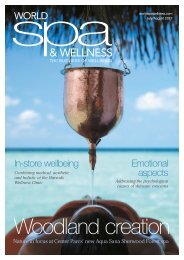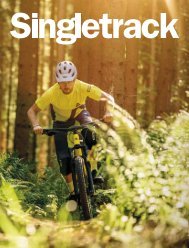You also want an ePaper? Increase the reach of your titles
YUMPU automatically turns print PDFs into web optimized ePapers that Google loves.
This is because when you sleep on down it’s<br />
crushed and becomes less effective so more of<br />
it is located in other areas of the bag where it<br />
works better.<br />
This means a sleeping mat is important and<br />
the extra insulation it gives so it’s got a neat trick;<br />
there’s two soft wide(ish) elasticated straps on the<br />
base of the bag that you feed your sleeping mat<br />
into to keep it in place whilst you sleep – contrary<br />
to some testers’ initial derision it worked well<br />
with no one finding themselves rolling off the<br />
mat. We found it worked beautifully with the<br />
Thermarest XTherm. On the sample we had, the<br />
straps were permanently in place but with the<br />
newer versions the straps are detachable.<br />
There’s a generous neck baffle and a full length<br />
two-way zip with a baffle to keep out the cold.<br />
The zip moves well with hardly any snagging. The<br />
fit of the bag was found to be roomy, especially<br />
around the body and hip area with plenty of space<br />
to move around and the well-shaped hood is<br />
generous too. Finally, there’s a small external<br />
zipped storage pocket near the bag entrance.<br />
There’s a long version for taller people and it<br />
comes with a stuff sack and storage bag.<br />
It is the heaviest on test (just) and the pack<br />
size wasn’t as small but for that you do get the<br />
warmest sleeping bag, and combined with the<br />
Thermarest XTherm sleeping bag it makes an<br />
excellent sleeping system.<br />
Western Mountaineering Highlite<br />
Weight: 455g Comfort limit: 2C RRP £365<br />
Not a name familiar with many UK buyers, Western<br />
Mountaineering have built a strong reputation in the<br />
US, due in no small part to the quality of construction<br />
and materials they use. There are three sizes: short,<br />
regular and long – it packs down extremely small,<br />
the smallest on test and also the lightest at 455g.<br />
It’s constructed with a stitch-through baffled<br />
box construction and to avoid cold spots they<br />
use baffled vertical seams with a 4cm netting to<br />
separate the inner and outer fabric thus allowing the<br />
down to fill the gaps and hey presto, no cold spots.<br />
In terms of features, to get it down to such a light<br />
weight it’s very stripped down with a half-length<br />
non-baffled zip and no neck baffle. Creating such a<br />
light bag is about compromise and they’ve covered<br />
the main features needed in a good bag. This is<br />
evident in the use of 225g of high quality 850+ fill<br />
power down with high loft coupled with a light,<br />
but reasonably durable, ‘Extremelite’ shell fabric.<br />
The bag was used down to around 4C at the<br />
lowest and no one complained of being cold but<br />
it would have been nice to try it at a lower<br />
temperature. A criticism though was the zip, it<br />
comes undone at its base and was a fiddle to put<br />
back together plus it was a bit slick and could<br />
slowly creep down if you didn’t fasten it all way<br />
up and use the Velcro fastening at its top to<br />
secure it. The toggle on the zip was also a bit<br />
small and fiddly. Perhaps Western Mountaineering<br />
should look at the choice of zip. The hood<br />
looked like an area that had been trimmed down<br />
and was a little shallow with headspace feeling<br />
cramped and the hood closing system didn’t<br />
close up as well as others.<br />
The cut of the bag is fairly narrow; some<br />
found it snug, particularly around the hips and<br />
feet, whilst for others it wasn’t an issue and there<br />
was sufficient space. It’s always difficult for a<br />
manufacturer to size a bag to fit all shapes and<br />
Western<br />
Mountaineering<br />
HighLite<br />
sizes, so follow the simple rule; try before you<br />
buy. In summary, there are compromises but if<br />
you want an ultra-light, well-made bag with<br />
first-rate down filling that takes up hardly any<br />
space in your pack then look no further that<br />
the HighLite.<br />
Sleeping Mats<br />
There are loads of different mats on the market but<br />
given the parameters of this review we focused,<br />
in the main, on lightweight air inflated mats.<br />
Each mat is given an R-value; basically the<br />
higher the figure the warmer the mat is. Thermal<br />
resistance is the measurement that indicates a<br />
material’s ability to insulate and there are two versions<br />
of the R-value, the US Method that basically<br />
gives a higher reading due to a difference on how<br />
the reading is made using imperial units, and the<br />
SI version that is used in most other parts of the<br />
world. So to help you, and acknowledge that<br />
most of the mats here use the US method, we<br />
adopted both systems for this review.<br />
With an air-filled mat most of the body heat is<br />
lost through radiation which in turn establishes<br />
convection currents within the mat. One way of<br />
combating this is by incorporating reflective<br />
layers to reflect the radiant heat back to the user.<br />
Sometimes it’s combined with a light insulation<br />
layer to help break down the convection currents<br />
resulting in a warmer mat for use in colder<br />
weather. Given the two to three season use we<br />
are looking at all the mats are suitable, however,<br />
using a warmer mat means you can often get<br />
away with a lighter weight sleeping bag and thus<br />
less weight to carry.<br />
A point worth highlighting is inflating the mat.<br />
For years people have used their own breath to<br />
inflate, the down side of this is your breath contains<br />
moisture and you can transfer some of that into<br />
the mat. This eventually leads to a build up of<br />
fungus on the inside of the mat and a breakdown<br />
of the material. To combat this some manufacturers<br />
either coat the inside to prevent the fungus<br />
growing and/or provide another means of<br />
inflation – often in the shape of a pump or a bag/<br />
air capture inflation device. The beauty of this is<br />
that the mat lasts longer and you don’t get light<br />
headed from blowing. Of course, this adds extra<br />
weight so most people stick to good old breaths.<br />
Brand/Model<br />
Price<br />
(RRP)<br />
Weight<br />
(grams)<br />
Exped AirMat HyperLite M<br />
Weight: 310g RRP £110<br />
The lightest on test and with a tiny pack size, it’s<br />
pretty amazing that it inflates to a thickness of<br />
7cm and offers a small degree of warmth. Inflated<br />
to its fullest it offers a firm platform and you can<br />
make it a little softer to your taste by letting a<br />
little air out – something which most testers did.<br />
The tapered mummy shape helps reduce<br />
weight further and that gives width at the<br />
shoulder and less at the feet (common with most<br />
mats on test). The vertical centre air cells/baffles<br />
are smaller on the inside of the mat and wider on<br />
each edge of the mat help prevent you rolling off.<br />
R-value<br />
(SI)<br />
R-value<br />
(us)<br />
Dimensions<br />
(regular<br />
size)<br />
Exped AirMat HyperLite M £110 310 0.33 1.9 183 x 52 x 7cm<br />
Klymit Static V2 £72 463 0.23 1.3 183 x 59 x 6.5cm<br />
Sea to Summit UltraLight £90 395 0.12 0.7 183 x 55 x 5cm<br />
Sea to Summit Insulated UltraLight £105 488 0.58 3.3 183 x 55 x 5cm<br />
Therm-a-rest Evolite £105 528 0.37 2.1 183 x 51 x 5cm<br />
Therm-a-rest NeoAir XTherm £165 430 1.00 5.7 183 x 51 x 6.3cm<br />
72 Sep–Oct <strong>2017</strong> www.climber.co.uk






